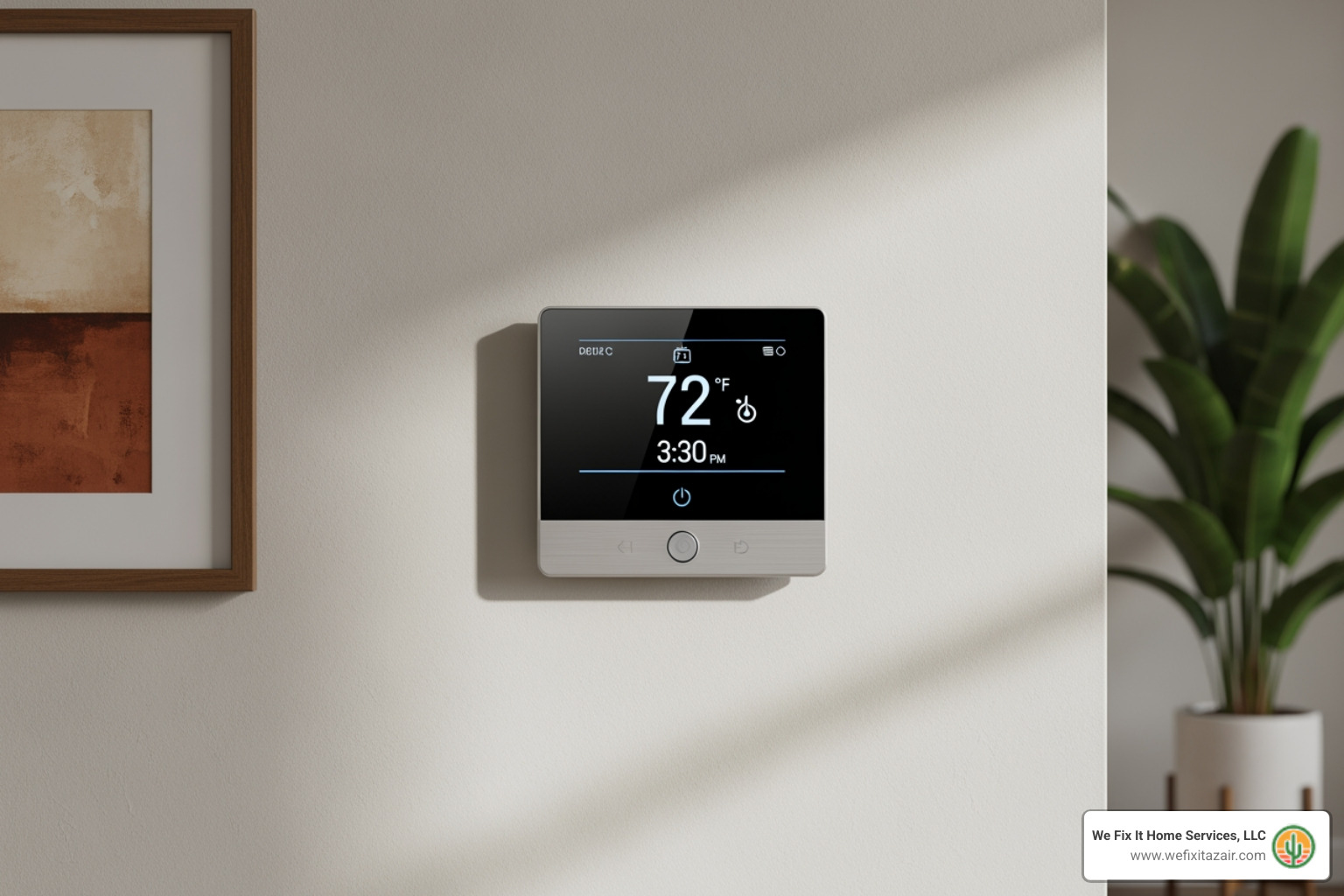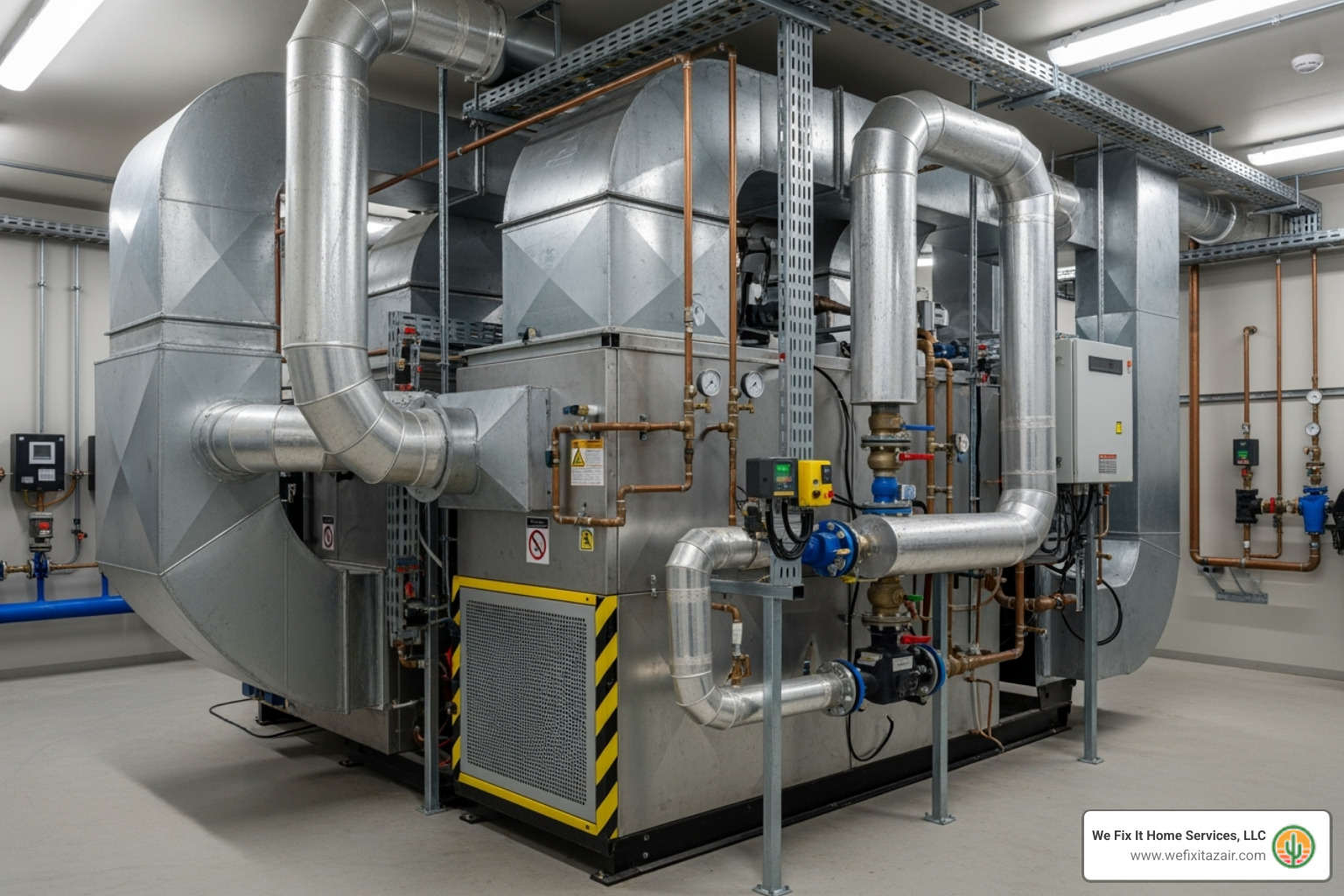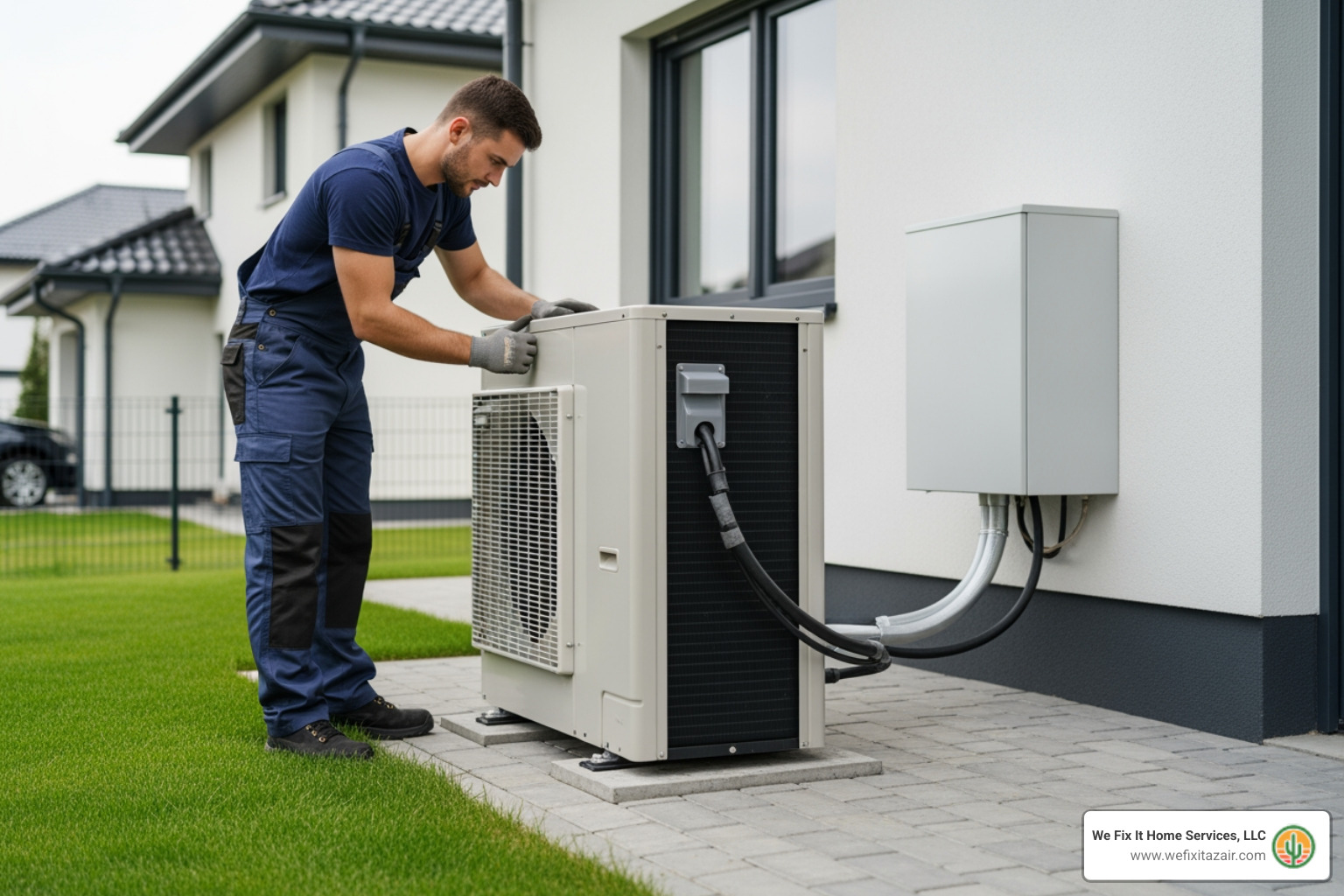Is Your AC on the Fritz? Expert Tips for Air Conditioner Repair
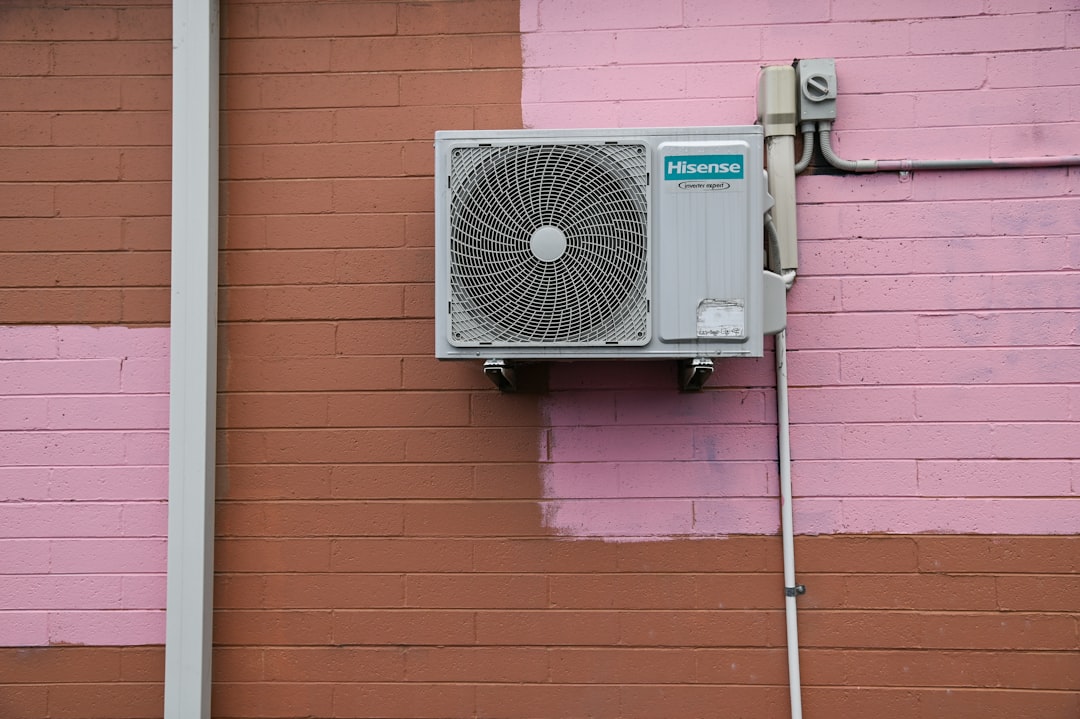
When Arizona's Heat Meets AC Problems
Air conditioner repair is critical when you're facing 110-degree temperatures and your AC quits. In Arizona's extreme climate, a broken AC isn't just an inconvenience—it's an emergency that can make your home uninhabitable.
Quick AC Repair Guide:
- Strange noises (grinding, squealing, banging) = mechanical issues
- Weak airflow = dirty filter or blocked ducts
- Warm air blowing = refrigerant leak or compressor problem
- Ice on coils = airflow restriction or refrigerant issues
- Water leaks = clogged drain or damaged condensate pump
- High energy bills = system working inefficiently
Most AC repairs fall into three categories: minor fixes (1-2 hours), moderate repairs (2-4 hours), and complex issues (4-6+ hours).
The key is knowing when to handle simple maintenance yourself (like changing filters) versus when you need a professional. With units over 10-15 years old, you must also consider if repair or replacement makes more financial sense.
Arizona's monsoon season, with its dust storms and humidity, creates extra challenges for your cooling system. Small problems can quickly escalate when your AC runs constantly to combat extreme heat.
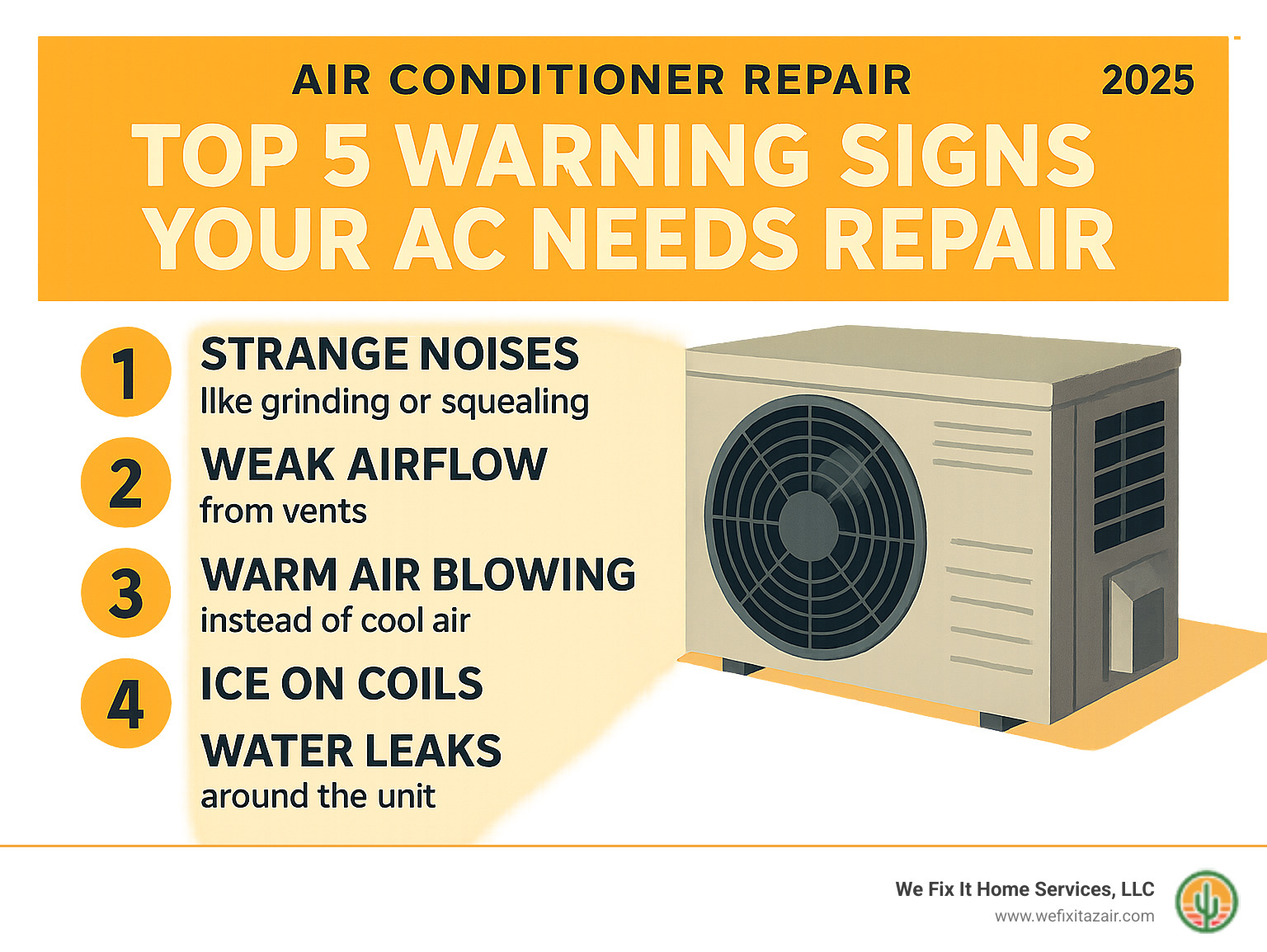
Diagnosing the Problem: Common AC Issues & Warning Signs
Walking into a warm home on a scorching Arizona day is never fun. Thankfully, your AC system usually gives warning signs before it completely gives up. Recognizing these signals can save you from discomfort and expensive emergency repairs.
Poor cooling is often the first red flag. Your AC might run constantly but never reach the set temperature, or you may experience uneven cooling, where some rooms are much colder than others.
Keep an eye on your energy bills. A sudden spike without an obvious reason means your AC is likely working overtime to compensate for a problem, consuming more power.
Frequent cycling—when your unit turns on and off in short bursts—is another telltale sign that usually points to thermostat or sizing issues.
Don't ignore water leaks around your indoor unit. These puddles can cause serious water damage and mold growth, and they usually happen when drain lines get clogged or condensate pumps fail.
Trust your senses. Unusual odors from your vents might indicate mold or burnt electrical components. If your AC starts making unusual noises like grinding, squealing, or banging, it's time for professional air conditioner repair.

Refrigerant Leaks and Performance
Refrigerant is the chemical that cools your home by absorbing heat from inside and moving it outside. When you have a refrigerant leak, your system can't do its job properly.
The most obvious sign is cooling inefficiency. You might also spot ice buildup on your refrigerant lines or evaporator coil, which happens because low refrigerant pressure causes components to get too cold. You might also hear hissing sounds near your unit as refrigerant escapes.
Refrigerant doesn't get "used up" over time; if it's low, there's a leak. This creates both environmental risks and safety concerns, as these chemicals are potent greenhouse gases.
That's why professional handling is essential. A qualified technician must find and fix the leak before recharging the system. Simply adding more refrigerant without fixing the leak won't solve the problem and could cause more damage.
Electrical and Component Failure
Your AC is a sophisticated electrical machine, and when a component fails, the whole system can stop. A failed capacitor is a common electrical issue. It provides the initial push for the motors, and a failing one often causes clicking noises as the system struggles to start. Ignoring a failing capacitor can cause motors to burn out, turning a simple fix into an expensive one.
Other electrical issues include blown fuses, tripped breakers, or a worn contactor (an electrical switch), which can cause similar starting problems.
Then there are compressor issues. The compressor is the heart of your AC, circulating refrigerant. A failing compressor can cause inadequate cooling, strange noises, or a complete shutdown. Because compressors are complex and expensive, their replacement is a major repair.
Airflow and Thermostat Troubles
Good airflow is essential for your AC system. Without it, the system works harder, energy bills rise, and components can be damaged. The biggest culprit is dirty air filters. When clogged, they reduce cool air production and can cause the system to freeze. Changing filters is an easy DIY task to keep your system healthy.
You can learn more about how a dirty air filter impacts your system and why regular filter maintenance is so crucial.
Blocked vents are another common problem. Keep all vents open and unobstructed, as your system is designed to work with them all open, and blocking them throws off its balance.
Clogged drain lines cause water leaks around your indoor unit. As your AC removes humidity, the water needs to drain. When the line is blocked by debris, water backs up.
Finally, a faulty thermostat, the system's brain, can cause incorrect temperature readings, uneven cooling, or frequent cycling. Sometimes the fix is simple, like new batteries, but complex malfunctions require professional air conditioner repair.
The Repair Roadmap: Timelines, Costs, and Key Decisions
When your AC breaks in Arizona's heat, you want to know two things: the cost and the timeline. Understanding the air conditioner repair process helps you make smart decisions. Most AC issues require professional expertise, as DIY repairs on refrigerant or electrical systems are dangerous and can void your warranty. The process involves understanding costs, timelines, and deciding whether to repair or replace your unit.
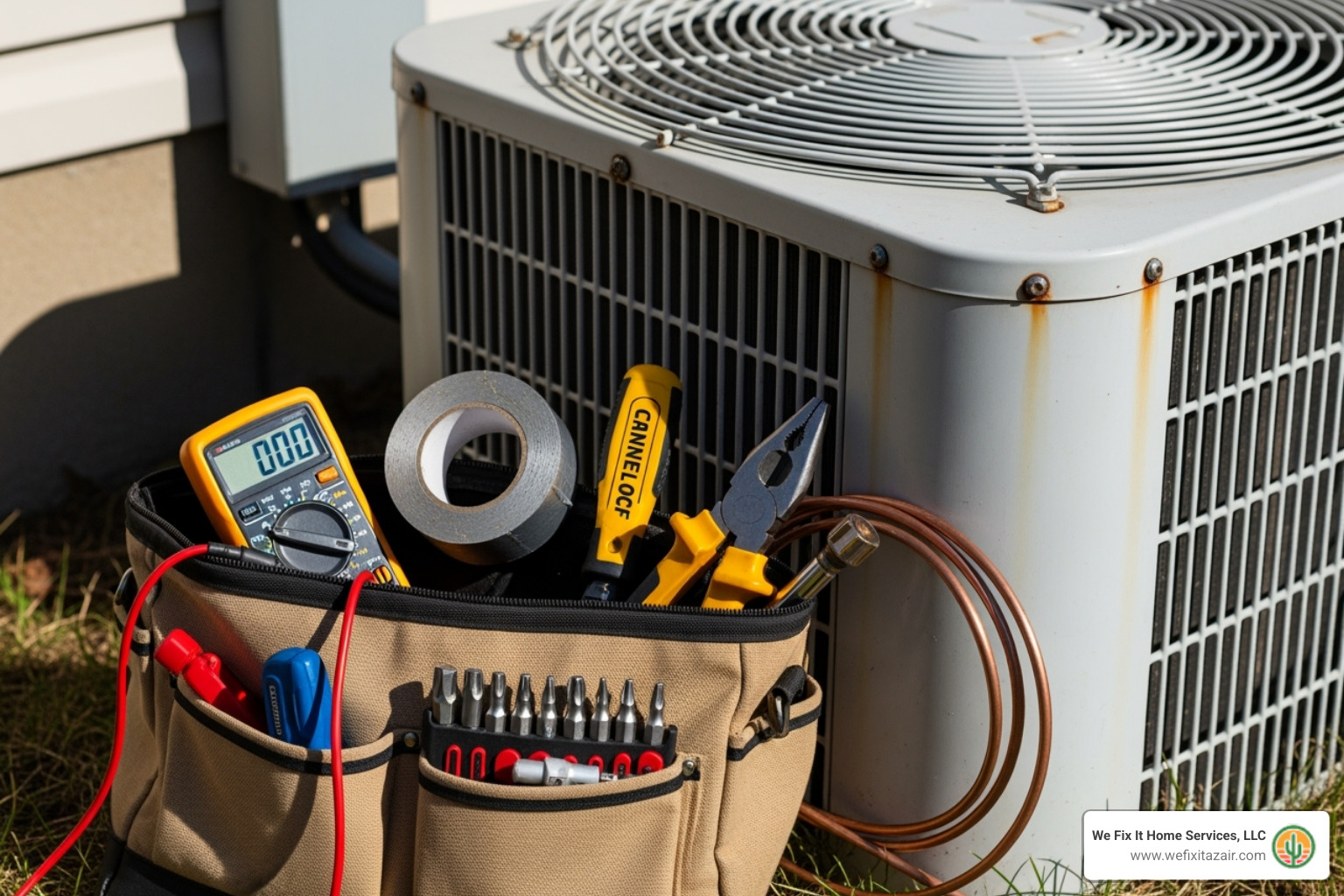
What Are the Costs of Common Air Conditioner Repair Jobs?
Air conditioner repair costs vary depending on the problem. Minor repairs are straightforward component swaps, like a faulty capacitor or contactor. These parts are inexpensive and quick to install, often taking less than an hour.
Moderate repairs are more complex, like fixing a refrigerant leak. This involves locating and sealing the leak before recharging the system, not just a simple "top-off."
Major repairs, like a compressor or coil replacement, are significant investments. The compressor is the heart of your system, and its replacement is complex and time-consuming. Damaged coils also significantly impact your system's ability to transfer heat.
These costs reflect not just the parts but also the expertise, tools, and warranty that come with professional service. A proper repair prevents bigger problems later.
How Long Does a Typical AC Repair Take?
The timeline for an air conditioner repair depends on the issue, but many jobs are quicker than you might think.
Quick fixes like thermostat or capacitor swaps usually take 1-2 hours. A capacitor replacement can take less than an hour but requires professional handling of electrical components.
Standard repairs take 2-4 hours. This includes fixing refrigerant leaks or cleaning coils, which require detailed attention and testing.
Complex repairs can take 4-6+ hours. A compressor replacement can take over six hours due to the intricate process of removing refrigerant, installing the new unit, and testing. Coil repair can also take several hours depending on accessibility.
Parts availability can extend timelines if a specialized part needs to be ordered. We stock common components to minimize delays.
Repair vs. Replace: Making the Smart Financial Choice
Deciding whether to repair or replace your AC is a tough decision, balancing immediate costs with long-term value.
| Factor | Repair Makes Sense When... | Replacement Makes Sense When... |
|---|---|---|
| Unit Age | Your AC is under 10 years old and has been reliable | Your unit is over 10-15 years old and struggling with efficiency |
| Repair Costs | The repair costs less than 50% of a new system | Repair costs approach or exceed 50% of replacement cost |
| Breakdown Frequency | This is an isolated problem after years of reliable service | You're calling for repairs multiple times per year |
| Energy Efficiency | Your current unit has a decent SEER rating and reasonable utility bills | Your energy bills keep climbing despite normal usage |
| Warranty Coverage | Your unit is still under warranty, covering major components | You're paying full price for parts and labor on an aging system |
The "50% rule" is a good guideline: if a repair costs half or more of what a new system would cost, replacement is often the better financial choice.
Unit age is a key factor. In Arizona, ACs last 10-15 years. Investing in a new unit may be better than a major repair on an older system.
Energy efficiency matters. New, high-efficiency systems have higher SEER ratings and can significantly lower your utility bills.
Frequent breakdowns signal your system is near the end of its life. If you're calling for repairs often, consider a replacement for better reliability.
We provide honest advice to help you decide between a cost-effective repair and a smarter long-term investment in a new system.
Finding a Pro: How to Choose a Reputable Air Conditioner Repair Company
When your AC fails during an Arizona summer, you need a qualified professional who won't leave you sweating over the results. The foundation of a trustworthy air conditioner repair company is proper licensing and certification, ensuring technicians meet industry standards.
Look for companies whose technicians hold NATE (North American Technician Excellence) certification, which demonstrates rigorous training and expertise. Experience is also crucial. A company that has served your community for years understands local climate challenges and has seen every type of AC problem.
Check customer reviews and reputation online for feedback on professionalism and quality. Word-of-mouth referrals are also valuable. Always choose an insured and bonded company to protect yourself from liability.
Before work begins, demand written estimates with detailed breakdowns. Reputable companies offer transparent pricing and won't pressure you. Look for companies that offer warranties on repairs and have availability for emergency services, which is critical in Arizona's heat.
Can I Perform My Own Air Conditioner Repair?
While the DIY spirit is great, some air conditioner repair tasks are safe for homeowners, while others require a professional.
Changing air filters is a key DIY task. Check your filter monthly during peak season and replace it when dirty to prevent your system from overworking.
Basic cleaning of the outdoor unit is another DIY job. Gently hose off the condenser coils to remove debris, but turn off the power first and use low pressure to avoid damaging the delicate fins.
Clearing minor drain line clogs can also be a DIY task. A wet/dry vacuum can often clear simple blockages causing water to pool.
However, any work involving refrigerant or electrical components requires a professional. Handling refrigerant is hazardous and legally requires EPA certification, while electrical work poses serious safety risks. Complex DIY repairs can also void your warranty. If you hear strange noises, feel warm air, or are unsure about a problem, call the professionals.
What to Look For in a Qualified Technician
A qualified technician ensures reliable cooling and prevents recurring problems. Here's what to look for:
NATE certification is the gold standard in HVAC. These technicians have passed comprehensive exams and stay current with ongoing training.
Real-world experience is vital. An experienced technician can diagnose problems faster and more accurately.
Check customer reviews for feedback on punctuality, cleanliness, and communication. A great technician explains the problem and how to prevent it.
Transparent pricing is key. A qualified technician provides a detailed written estimate before starting work and avoids high-pressure sales tactics.
Emergency availability is crucial in Arizona. A good company understands that AC failure can be dangerous and offers prompt service with the right tools and parts.
Prevention is Key: The Power of Regular AC Maintenance
Just like your car needs regular oil changes, your air conditioner requires the same level of care. Preventative maintenance is essential in Arizona's relentless heat, where your AC works overtime.
Regular AC maintenance extends your AC's lifespan by reducing wear and tear on components. A smooth-running system lasts longer, delaying a costly replacement. A well-maintained system also improves efficiency. Clean coils, fresh filters, and lubricated parts mean your AC doesn't struggle to cool your home, which lowers your utility bills.
Maintenance is key to preventing breakdowns. Technicians can spot minor issues like low refrigerant levels, loose electrical connections, or clogged condensate drains before they become major, expensive problems.
During annual tune-ups, technicians clean coils, check refrigerant, inspect electrical connections, lubricate parts, and ensure proper airflow for peak performance.
Everyday things can also damage your AC. For instance, pet urine is acidic and can corrode the coils and fins on your outdoor unit, leading to costly replacements. You can learn more about Why you should prevent pets from damaging your AC unit.
Regular maintenance also keeps your equipment warranty valid, as many manufacturers require proof of annual service to honor their warranties. It's an investment that protects both your comfort and your wallet.
Conclusion
When you need air conditioner repair in Arizona's brutal heat, you're now equipped to handle it like a pro. We've covered everything from the first warning signs to the big decision of repair versus replacement.
The most important takeaway is: Don't wait. A minor issue like a strange smell or weak airflow can lead to a complete system failure during a heatwave. We've seen too many families suffer through 115-degree days because a small problem was ignored.
Professional service ensures your AC runs safely and efficiently. While you can change an air filter, complex issues with refrigerant, electrical parts, or the compressor require a NATE-certified technician who can spot and fix problems correctly, preventing bigger headaches later.
At We Fix It Home Services, we understand the importance of home comfort in Pinal and Maricopa Counties. As a family-owned company, our NATE-certified technicians treat every air conditioner repair with care, from simple fixes to full system overhauls.
We offer maintenance plans, financing, and extended warranties to be your long-term partner in home comfort. In Arizona, a working AC is a necessity, not a luxury.
Ready to get your cool back? We're standing by to help.




















Customer Testimonials























